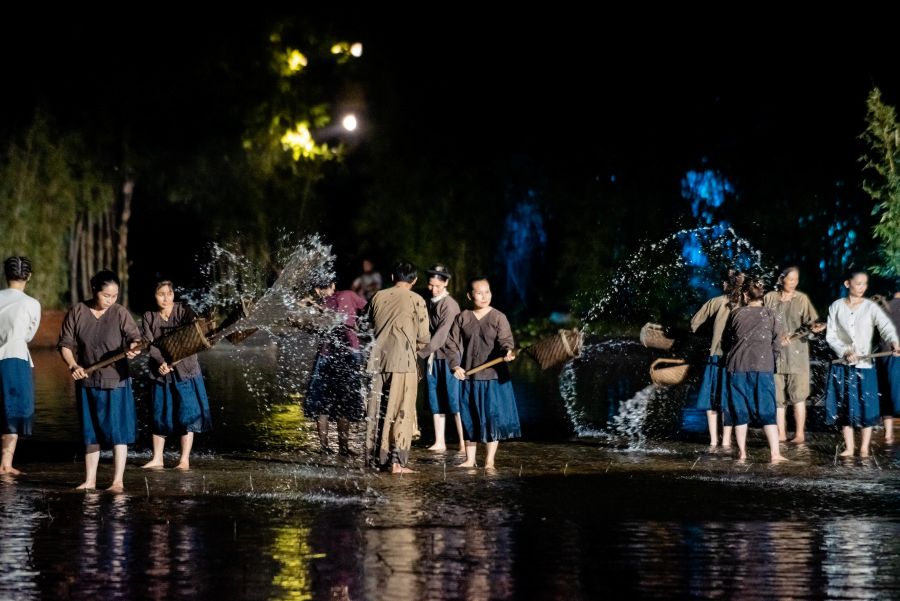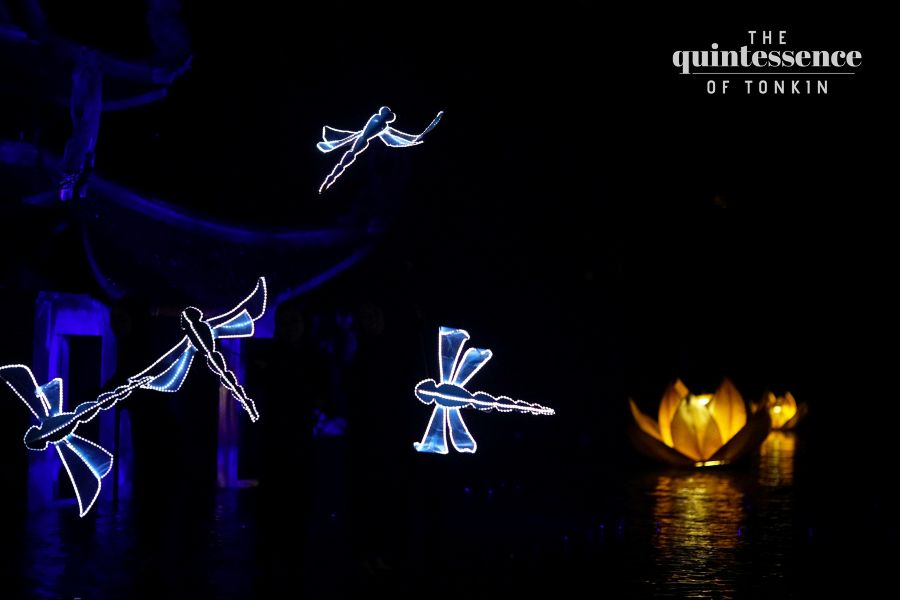The rich history of water puppetry and the Royal Citadel of Thang Long-Hanoi comes to life in a spectacular live performance featuring local actors.
Every Wednesday, Saturday, and Sunday at 7:30 PM, locals and visitors to Hanoi have the opportunity to experience the live spectacle “Tinh hoa Bac Bo” or “The Quintessence of Tonkin” at Baara Land, an entertainment and dining complex in Da Phuc Village, Sai Son Commune, Hanoi.
The Illustrious life of Zen Master Tu Dao Hanh

The title of the show, “The Quintessence of Tonkin,” suggests a presentation of Vietnamese folk art alongside the spiritual life and cultural beliefs of northern Vietnam.
Inspired by the spiritual history of the nearby Thay Pagoda, the show tells the story of the pagoda’s founding by the venerable monk Tu Dao Hanh and explains the ancient union between religion and the monarchy. Audiences will experience six aspects of the northern culture: poetry, Buddhism, nostalgia, music, painting, joy, and celebration. The show takes the audience back to a pristine time in the countryside, where they will feel the sacred atmosphere and the cultural crystallization of the land with thousands of years of literature.
The spectacle begins with a scene of noisy fishermen sweeping their paddles through the water and calling out to each other. After a lullaby sounds from a thatched hut, the venerable monk Tu Dao Hanh steps out into the mist, strikes his wooden bell and prays for a peaceful life for his people. From the steps of the Zen Master, a lotus blossoms. Tu Dao Hanh is known for his humility and generosity to the poor. Legend has it that he invented water puppetry to depict the lives of the rural population. Since then, the art form has become part of Vietnam’s cultural and spiritual life.
Audiences gain insight into the culture of northern Vietnam, the history of the founding of the Red River Delta provinces, and the daily lives of its people. While water puppetry reflects myths and legends through storytelling, “The Quintessence of Tonkin” showcases live performers ‘dancing’ on the water, bringing to life stories of everyday life.

“No one can better express the authenticity and vibrancy of the cultural, spiritual and religious life of the northern countryside than the people who live there,” said Hoang Nhat Nam, former director of ‘The Quintessence of Tonkin’, about his three-year experience living and working with the actors from Da Sy village in Sai Son commune, Quoc Oai District, on Hanoi’s outskirts. “They don’t just “act”; they show their daily lives on stage and view the audience as visiting “friends”. Their attitude inspires us to overcome the hardships and pressures of work. And I’m truly grateful to them.”
Technology to enhance folk art
The main stage is a 4,300-square-meter lake, with the mist-covered Sai Son Mountain serving as a stunning backdrop, surrounded by rice fields and lush greenery. In addition to the dancers, who are students from the Vietnam College of Dance, the other 100 performers are all villagers.
“It took us almost a year to persuade the farmers, who only know how to work their fields, to become actors under the spotlight,” said Cong Vu, one of the producers. “By day, they work their fields while their children go to school, but as night falls they transform into ‘artists’. Our oldest performers are over 80 years old, while our youngest is a ten-year-old boy.”

“I’m a fortunate traveler and have had many chances to watch spectacles in China, Thailand, Malaysia, Australia, and Vietnam,’ said Tina Do from Hanoi, who saw ‘The Quintessence of Tonkin’. ‘There’s no doubt that the show is worth watching. It’s on par with international productions in terms of sound effects, lighting, and technical effects on the stage.”
The producers of “The Quintessence of Tonkin” invested nearly $100,000 in cutting-edge equipment to create unique effects in the lighting and sound systems. The theater itself is an engineering feat. A natural lake was transformed into a stage, including a state-of-the-art hydrothermal system that raises the 15-ton Thuy Dinh (Water Pavillion) out of under the water in less than a minute. With Sai Son Mountain as the backdrop, they also had to develop a unique illumination system to light up the hills, 1.5 kilometers away with 40 1,500-watt lamps.
“When Thuy Dinh came out of the water, I couldn’t stop applauding,” Tina Do said. ‘Each part of the scene was elaborate. I was eager to see what would happen next. With hundreds of actors and an elaborate script, paying VND800,000 (or US$32) for a diamond ticket is acceptable.’

Other great scenes followed the water puppetry show in front of Thuy Dinh. The audience burst with emotion as four beautiful girls stepped out of a Hang Trong folk painting called ‘To nu’ (a collection of four paintings showing four young Vietnamese women with long hair and long dresses, standing in four different poses: one playing a flute, one holding a Senh tien – a combination of clapper, rasp, and jingle made from three pieces of wood and old Chinese coins, one holding a fan, and one holding a moon-shaped guitar).
The combination of lights, music and the actors’ interactions with the mapping technology and projectors created a wonderful moment as if the audience were in the fairy land scene. It’s probably the most beautiful scene in the show.
Other Tonkinese quintessences are ca tru or ceremonial singing, quan ho or love duet singing and hau dong or a mediumship ritual. Scenes simulating Vietnamese students going to exams in ancient times and the Goddess worship procession were also reproduced on stage.

During the 60-minute-show, the audience is also thrilled by lively dragon boat races and dazzling fireworks but also sometimes subdued by scenes of people praying to Buddha or of village scenes with swarms of dragonflies.
According to a representative from the show’s producers, “The Quintessence of Tonkin” is designed to give local people, especially the younger generation, a deeper understanding of their heritage, while also creating a lasting impression of Vietnamese folk culture on international visitors.
For years, “The Quintessence of Tonkin” has been a must-see show for visitors to Hanoi, offering a glimpse into Vietnam’s rich folk culture.
By Jenna Duong. Photo: Tuan Chau Hanoi
| Located 25 km west of downtown Hanoi, “The Quintessence of Tonkin” occupies a large space at the Baara Land Entertainment Complex, close to Chua Thay (Thay Pagoda), a special national heritage site and one of the oldest Buddhist pagodas in Vietnam. The Pagoda can be easily visited in conjunction with a trip to see “The Quintessence of Tonkin”, which helps frame the spectacle. Performances are held every Wednesday, Saturday, and Sunday evenings at 7:30 PM. The venue can accommodate up to 2,000 guests at a time. It takes just 40 minutes to reach the venue by bus from the show’s bus stop at Chamvit Tower, located at No. 117 Tran Duy Hung Street, Cau Giay District. A round-trip ticket costs VND 100,000 (about $4). The bus departs from Chamvit Tower at 5:30 PM and picks up the audience at Baara Land at 8:45 PM. |




